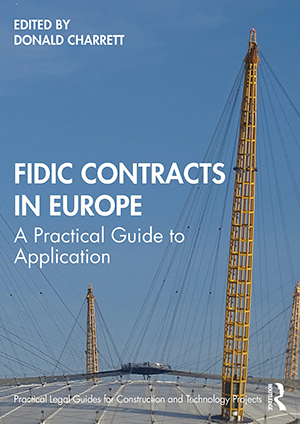CLInt – Book Reviews – December 2022

FIDIC Contracts in Europe: A Practical Guide to Application
Edited by Donald Charrett
Published by: Routledge
ISBN: 9781032062235
692 pages, £150
Publication date: 29 November 2022
Reviewed by William Godwin KC
FIDIC 2017 Updates Task Group, London
www.3harecourt.com
Since their publication in 1999, the FIDIC rainbow suite of the Red, Yellow and Silver Books (first edition) have become the most widely used engineering standard form contracts internationally, and among the best regarded. Although having their origins in the UK ICE Conditions of Contract, via a series of amended and updated previous forms, FIDIC contracts are used whatever the background of the parties or their familiarity with common law.
A major reason for this success has been the perception that the contracts strike a reasonable and appropriate balance between the interests of contractors and employers respectively; I say ‘appropriate’, because, although the Silver Book (for which there was no ancestor in the FIDIC family tree) contains a radically different risk allocation from the other two books, placing substantially all of the risks of procurement, design and construction (with some important exceptions) on the contractor, this form was developed precisely to meet a specific type of project financing need and filled a gap that had previously been filled by often unsatisfactory ad hoc amendments to other forms.
The success of the FIDIC forms has also been due to FIDIC’s historical willingness to amend and update the contracts to reflect experience of their use and developments in international contracting. This willingness was no more clearly demonstrated than with the publication, in 2017, of the second edition of the Red, Yellow and Silver Books.
I had the privilege of serving as legal member of the Updates Task Group which drafted the 2017 forms. A key aim of the new contracts was to increase clarity and certainty, so users will find several new definitions, which are now in alphabetical order (Sub-Clause 1.1). ‘Claim’, ‘Dispute’, ‘Notice’ and ‘Programme’, for example, are now defined terms; ‘may’, ‘shall’ and ‘consent’ are also defined, with the particular aim of assisting those whose first language is not English. ‘Plus reasonable profit’, as used in the 1999 editions, often caused difficulty. A new definition, ‘Cost Plus Profit’, now applies, and refers to a percentage for Contractor’s profit to be stated in the Contract Data, or in default five per cent.
One very significant procedural change concerns notices. As noted above, ‘Notices’ is now a defined expression. By a new Sub-Clause 1.3, a notice must be in writing and identify itself as such, among other requirements. Notices are now required in many more situations than previously and, when given, trigger time limits. Other changes include the Engineer’s or Employer’s Representative’s role in agreeing or determining any claim or other matter arising under the contract; this is set out in greater detail than in the 1999 Books, and in a step-by-step fashion with time limits. Claims are now dealt with in a new Clause 20 and in the same way for contractor and employer.
Like many others who act as arbitrators or adjudicators, I have long supported methods of reducing or avoiding disputes when issues arise in a project. In the 2017 contracts, a new Clause 21 sets out a substantially revised disputes process, including an enhanced role for the renamed Dispute Avoidance/Adjudication Board (DAAB) in helping resolve disputes before an arbitration is commenced.
In his introduction to this new book, Donald Charrett places the 2017 FIDIC contracts in the context of construction contracts more generally and the development of the FIDIC forms. In chapter 2, he deals with many of the underlying features of the contracts when examining the FIDIC Golden Principles. This book is part of a series covering the application of FIDIC contracts globally, with the focus here being on their application in Europe. Dr Charrett brings to this task a wealth of experience and knowledge of the contracts and of international construction.
Experts from several European jurisdictions describe the legal and regulatory aspects relevant to major projects; those covered are specifically Austria, Belgium, Czech Republic, Denmark, England & Wales, France, Germany, Greece, Ireland, Italy, the Netherlands, Norway, Portugal, Scotland, Sweden and Switzerland. The individual authors have written clear and often detailed guidance, indicating where further information might be obtained. The diversity of legal systems relevant to implementing not just a FIDIC but any major project in Europe is one of the most striking features of this work, and the contributions of the many individual authors will make it a valuable source of information to anyone involved in such projects.